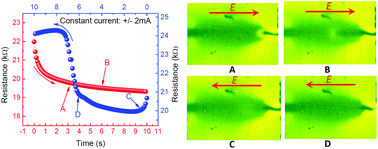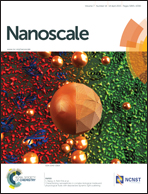Understanding the conductive channel evolution in Na:WO3−x-based planar devices†
Abstract
An ion migration process in a solid electrolyte is important for ion-based functional devices, such as fuel cells, batteries, electrochromics, gas sensors, and resistive switching systems. In this study, a planar sandwich structure is prepared by depositing tungsten oxide (WO3−x) films on a soda-lime glass substrate, from which Na+ diffuses into the WO3−x films during the deposition. The entire process of Na+ migration driven by an alternating electric field is visualized in the Na-doped WO3−x films in the form of conductive channel by in situ optical imaging combined with infrared spectroscopy and near-field imaging techniques. A reversible change of geometry between a parabolic and a bar channel is observed with the resistance change of the devices. The peculiar channel evolution is interpreted by a thermal-stress-induced mechanical deformation of the films and an asymmetric Na+ mobility between the parabolic and the bar channels. These results exemplify a typical ion migration process driven by an alternating electric field in a solid electrolyte with a low ion mobility and are expected to be beneficial to improve the controllability of the ion migration in ion-based functional devices, such as resistive switching devices.



 Please wait while we load your content...
Please wait while we load your content...